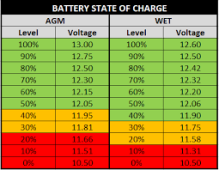SunnySoCal
New Member
- Joined
- Jan 8, 2022
- Messages
- 49
This question has been brought up by me and others in this thread. Note that the MOES device senses the battery voltage and will swap as a function of the two set points. It is not a failover to grid or vice-versa. I have my low voltage disconnect set at 11.4 V. I do have ~0.15 V lower reading on the MOES than at the battery...and not because of wire size...just an error of the MOES but ok as it is just a relative error. This LV cutoff translates (after rest recovery) to only about a 30% DOD. 12.3 V as measured at my (isolated by my marine switch) flooded lead acid battery. My reenable set to 13.5 V.Reading this, I'm wondering if Vgrid->batt and Vbatt->grid are set too close for the battery bank size. Solution is either a bigger battery bank or to set those points further apart.
That said, your question (TorC) got me thinking more about these inverter failures. My system is basically set up to switch off at some point after the panels stop receiving sunshine and the battery goes below 11.4 V. This time of year I lose sun on the panels about 4 pm and the battery (if fully charged by then) will ride out until about 9 pm before hitting the 11.4 V. Because of how my system is set up there's no chance that I will have a rapid reenabling of the battery/inverter. I also look at the weather every day and if it's not likely to get a good charge on the battery I will keep my loads down to ~50 Watts.
So I'm curious if anyone with a failed inverter has had the device switch to grid during the day under a heavy load. In particular, if the load is excessive the battery can drain rapidly especially if the SOC is low to begin with. And couple that with the possibility of clouds coming and going there is a possibility of the sun popping out of a cloud simultaneously with the MOES switching to grid (due to heavy load and cloud cover) and back (strong sun will raise panel and thus battery voltage). Also, curious as to voltage set points as indicated by TorC. Please post your settings at time of failure. Note that I have almost 2 volts between the two set points. That may not be enough if MOES is switching during the day.
But as likely as not the continuous pounding of high inductive loads can be the source of your inverter failures. Break-delay-make if your system runs this way.




